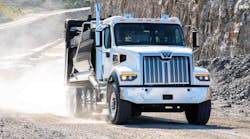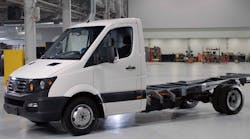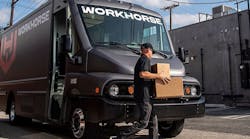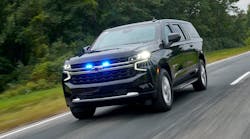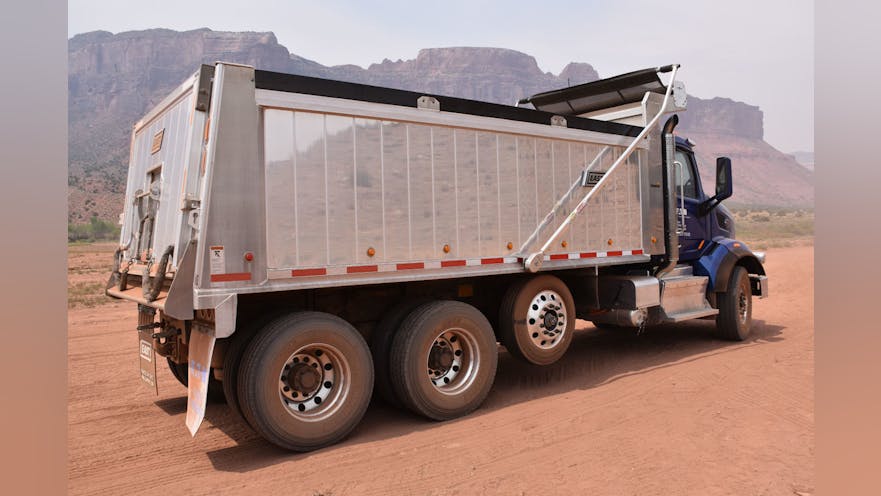GATEWAY, CO. Vocational truck customers know what they need. The question becomes: What can they get—and will it do the job? To demonstrate its ability to deliver durable, safe, customized solutions, Peterbilt Motors Co. recently hosted select work truck customers to a multi-vehicle test drive—on a two-mile off-road course designed for Baja trophy trucks.
“We have a lot of information to share, but we always come way from these events with a better understanding of what your expectations and your requirements and your desires are,” said Scott Chowaniec, general sales manager for vocational and medium duty at Peterbilt, in welcoming the customers.
Peterbilt produced more than 41,000 trucks in 2017, and set market share records in heavy duty (15.3%), vocational (20%) and refuse (30%), Chowaniec noted.
Along with product experts from Peterbilt, supplier reps were on hand from Eaton, Meritor, and Bridgestone.
The event was designed to highlight “the Peterbilt customizable product,” especially for work truck customers, explained Tony Sablar, Peterbilt’s vocational marketing manager.
“Vocational customers are looking for a truck that does the job. In order to be the best operating tool, it needs to be specifically designed. That’s right up Peterbilt’s alley,” Sablar said. “The customers appreciate the opportunity to get in the trucks, drive them, and have a comparison between different types of engines, suspensions, different specs—especially in an environment that’s similar to what they actually operate in. They also appreciate the opportunity to talk with other customers who are here. This has been a very conversational group.”
Sablar also emphasized the growing importance of safety to vocational customers. “We have a lot [of safety features] available. I want to make them aware, so the next time they look at a truck spec they’ll consider it.”
The Model 567, which debuted in the front-axle configuration five years ago, was a designed around vocational needs: cab width, driver reach, visibility. Finer adjustments include updates to dash displays, for instance. “Just the stuff drivers need to know, and making it easy to understand,” Sablar added.
Also of note: Automated and automatic transmissions have become the rule rather than exception in the vocational segment.
In terms of the market, construction is “extremely hot.”
“It was very good last year and has continued into this year,” Sablar said. “We’re on a record pace for vocational sales. We had record market share last year, and I wouldn’t be surprised if we surpassed that.”
As with other OEMs, the Peterbilt order book is already running into next year but the company has kept up with its delivery schedule—even as chassis availability has emerged as a leading challenge for upfitters.
“We have more flexibility. We are able to get chassis built faster,” Sablar said. “It takes a lot of communication, coordination, to get that entire asset competed. ‘If we get this chassis done early, can you get that body built?’”
The trucks
For the specs on the trucks featured in the test drive, see the slides above, but broadly each of the vehicles shared great visibility, had plenty of power (the 430 h.p. Paccar MX-11 held its own against the 510 h.p. MX-13 and the 600 h.p. Cummins ISX15), were easy to handle in the dirt with both the Eaton and Allison transmissions, and were considerably more comfortable than one might expect on a circuit built for desert racers (cold A/C certainly helps).
At the core of the Model 567 is a durable aluminum cab with strategically-placed steel reinforcements to increase strength and optimize rigidity.
In addition to cab durability, the signature stainless steel oval mesh grille and surround provide protection from gravel and road debris. The Metton hood is built to absorb many impacts that would shatter or crack other materials.
A panoramic windshield provides maximum forward visibility. A-pillars utilize strategically placed supports for added strength, allowing them to be narrower than other designs and further enhancing visibility.
The 567 can be spec’d with a wide variety of heavy-duty components and in a number of configurations for increased payloads and optimized weight distribution. The 567 is available in a set-back front axle configuration for increased maneuverability in congested worksites and with steer axle ratings up to 22,000 lbs. An angled steering gear installation further improves maneuverability by increasing wheel cut by up to 9 degrees over other designs, reducing curb-to-curb turning diameter by up to 9 feet.
The 567 is also available with single, tandem or tridem drive axles and a variety of lift axles.



